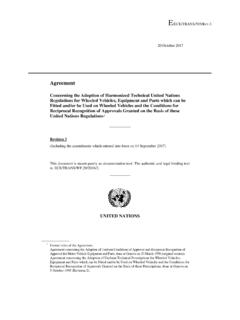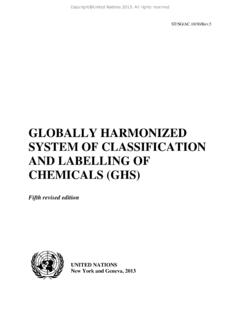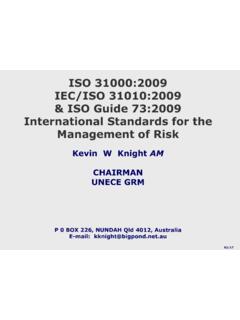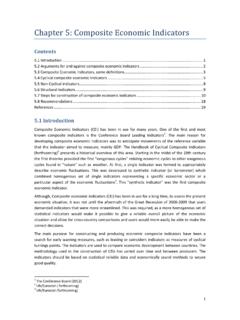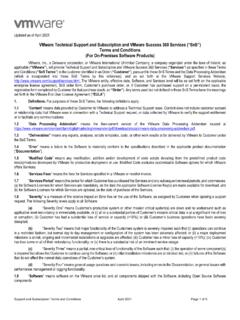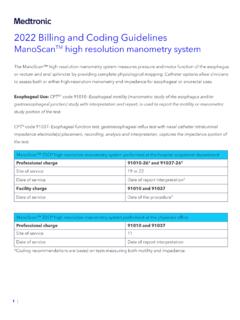Transcription of Addendum 20: Global Technical Regulation No. 20
1 ECE/TRANS/180 3 May 2018. Global Registry Created on 18 November 2004, pursuant to Article 6 of the Agreement concerning the establishing of Global Technical regulations for wheeled vehicles, equipment and parts which can be fitted and/or be used on wheeled vehicles (ECE/TRANS/132 and ) done at Geneva on 25 June 1998. Addendum 20: Global Technical Regulation No. 20. Global Technical Regulation on the Electric Vehicle Safety (EVS). Established in the Global Registry on 14 March 2018. UNITED NATIONS. (E).. ECE/TRANS/180 Global Technical Regulation on Electric Vehicle Safety (EVS). Contents Page I. Statement of Technical rationale and .. 7. A. Introduction .. 7. B. Procedural background .. 7. C. Technical background .. 8. D. Principle for developing the Global Technical Regulation .. 14. E. Technical rationale and justification .. 16. F. 57. G. Existing regulations , directives, and international voluntary standards .. 58. H.
2 Benefits and costs .. 61. II. Text of Regulation .. 63. 1. Purpose .. 63. 2. Scope .. 63. 3. Definitions .. 64. 4. General requirements .. 67. 5. Performance requirements .. 68. Requirements of a vehicle with regard to its electrical safety - in-use .. 68. Protection against electric 68. Functional 71. Requirements of a vehicle with regard to its electrical safety - post-crash .. 72. General principle .. 72. Protection against electric shock .. 72. Requirements with regard to installation and functionality of rechargeable electrical energy storage system (REESS) in a vehicle .. 74. Installation of REESS on a vehicle .. 74. Warning in the event of operational failure of vehicle controls that manage REESS safe operation .. 74. Warning in the case of a thermal event within the REESS .. 74. Warning in the event of low energy content of REESS .. 75. Requirements with regard to the safety of REESS - in-use .. 75. General principle.
3 75. Vibration .. 75. Thermal shock and cycling .. 76. Fire resistance .. 76. 3. ECE/TRANS/180 External short circuit protection .. 76. Overcharge protection .. 76. Over-discharge 77. Over-temperature protection .. 77. Overcurrent protection .. 77. Low-temperature protection .. 78. Management of gases emitted from REESS .. 78. Thermal propagation .. 78. Requirements with regard to the safety of REESS - post-crash .. 80. Vehicle based test .. 80. REESS-component based test .. 81. 6. Test procedures .. 82. Test procedures for electrical safety .. 82. Isolation resistance measurement method .. 82. Confirmation method for functions of on-board isolation resistance monitoring system .. 86. Protection against direct contact to live parts .. 87. Test method for measuring electric resistance .. 89. Test procedure for Protection against water effects .. 90. Test conditions and test procedure regarding post-crash .. 90. Test procedures for REESS.
4 94. General procedures .. 94. Vibration test .. 95. Thermal shock and cycling test .. 97. Fire resistance 98. External short circuit protection .. 102. Overcharge protection test .. 103. Over-discharge protection test .. 106. Over-temperature protection test .. 109. Overcurrent protection test .. 111. Mechanical shock test .. 112. Mechanical integrity test .. 114. 7. Heavy duty vehicles Performance requirements .. 116. Requirements of a vehicle with regard to its electrical safety - in-use .. 116. Protection against electric shock .. 116. Functional 120. 4. ECE/TRANS/180 Requirements with regard to installation and functionality of REESS in a vehicle .. 120. Installation of REESS on a vehicle .. 120. Warning in the event of operational failure of vehicle controls that manage REESS safe operation .. 121. Warning in the case of a thermal event within the REESS .. 121. Warning in the event of low energy content of REESS.
5 122. Requirements with regard to the safety of REESS - in-use .. 122. General principle .. 122. Vibration .. 122. Thermal shock and cycling .. 122. Fire resistance .. 123. External short circuit protection .. 123. Overcharge protection .. 123. Over-discharge 123. Over-temperature protection .. 124. Reserved .. 124. Low-temperature protection .. 124. Management of gases emitted from REESS .. 124. Thermal propagation .. 125. Requirements with regard to the safety of REESS simulating inertial load .. 126. Mechanical shock .. 126. 8. Heavy duty vehicles - Test procedures .. 127. Test procedures for electrical safety .. 127. Isolation resistance measurement method .. 127. Confirmation method for functions of on-board isolation resistance monitoring system .. 130. Protection against direct contact to live parts .. 131. Test method for measuring electric resistance .. 133. Test procedure for Protection against water effects.
6 134. Test procedures for REESS .. 135. General procedures .. 135. Vibration test .. 136. Thermal shock and cycling test .. 137. Fire resistance 138. External short circuit protection .. 142. Overcharge protection test .. 144. 5. ECE/TRANS/180 Over-discharge protection test .. 146. Over-temperature protection test .. 149. Reserved .. 151. Mechanical shock test .. 151. Annexes 1 Determination of hydrogen emissions during the charge procedures of the 154. Appendix 1: Calibration of equipment for hydrogen emission testing .. 165. 2 Verification method for testing authorities confirming document based isolation resistance compliance of electrical design of the vehicle after water exposure .. 168. 6. ECE/TRANS/180 I. Statement of Technical rationale and justification A. Introduction 1. Electromobility represents the concept of using electric powertrain technologies with a view to address climate change, improve air quality and reduce fossil fuel dependency.
7 The current regulatory pressure to lower CO 2 and pollutant emissions is helping to drive an increasing market penetration of vehicles utilizing electric powertrain (hereafter, "electrically propelled vehicles" or "EV"). Furthermore, many governments support the development and deployment of EV by financing research or offering incentives for consumers. Consequently, the automotive industry is investing in research and development, as well as the production capacity for electric vehicles, at a scale not seen in the past. 2. Together with support measures for industry development, many governments have already started to define their regulatory framework for EV, mostly in order to ensure their safety and thus gain consumer confidence, but also in consideration of environmental performance measures. 3. Because of the relatively small volume of EV and their components currently produced, any degree of convergence between regulatory obligations can result in economies of scale and cost reductions for automotive manufacturers critical in the context of economic recovery and the general cost-sensitiveness of the industry.
8 4. This United Nations Global Technical Regulation (UN GTR) introduces performance-oriented requirements that address potential safety risks of EVs while in use and after a crash event, including electrical shocks associated with the high voltage circuits of EVs and potential hazards associated with lithium-ion batteries and/or other Rechargeable Electrical Energy Storage Systems (REESS) (in particular, containing flammable electrolyte). 5. UN GTR requirements are based on the best available data, scientific research and analysis and reflect the outcome of Technical discussions between the experts representing the industry, testing authorities and the Governments of Canada, China, European Union, Japan, Republic of Korea and the United States of America. B. Procedural background 6. The Executive Committee of the 1998 Agreement ( ) gave, in November 2011, its general support to a joint proposal by the United States of America, Japan and the European Union to establish two working groups to address the safety and environmental issues associated with EVs.
9 That proposal (ECE/ and ) was submitted to the World Forum for Harmonization of Vehicle regulations ( ) at its March 2012 session for further consideration and formal adoption. has adopted this proposal with China as one of the co-sponsors together with Japan, United States and European Union. 7. The objective of the two working groups is to seek regulatory convergence on the Global scale via the work in the framework of the 1998 Agreement. Then, the Terms of Reference (TOR) for the electric vehicle safety (EVS) working group with the goal of establishing a UN GTR for EVs covering high voltage electrical safety, safety of electrical components, and REESS (ECE/ ) had been adopted at the one- hundred-and-fifty-eighth session of in March 2012. 7. ECE/TRANS/180 8. The aim of this working group is to sponsor an effort to develop one UN GTR (or more, if appropriate) to address the safety of EVs. 9. Other topics that the EVS informal working group could consider, insofar as these topics may be relevant for the Technical requirements to be developed, are: (a) The different standards for electro-mobility (vehicle inlets for charging).
10 (b) Best practices or guidelines for manufacturers and/or emergency first responders. 10. Given the complexity of issues discussed, the informal working group requested extension of the mandate twice, in November 2014 (ECE/ ) and November 2015 (ECE/ ), each time by one year. 11. To resolve particular Technical issues in an efficient manner, nine task force groups have been set up and met nine times between October 2014 and September 2016. Task force groups successfully addressed a large number of safety related issues according to the given mandate, however, more discussion is required on some critical issues, where research and testing of methods are still in progress. 12. Under such circumstances, the informal working group agreed that the most appropriate way to establish the UN GTR within the given mandate was to address the agreed safety issue in Phase 1 while leaving those safety requirements that require long- term research and verification for Phase 2, which is expected to start as soon as possible.
